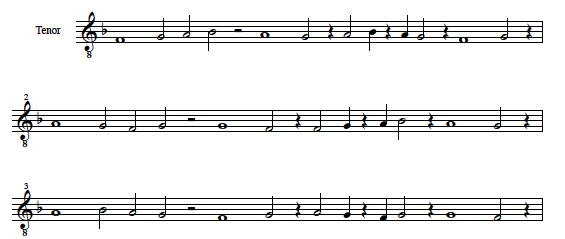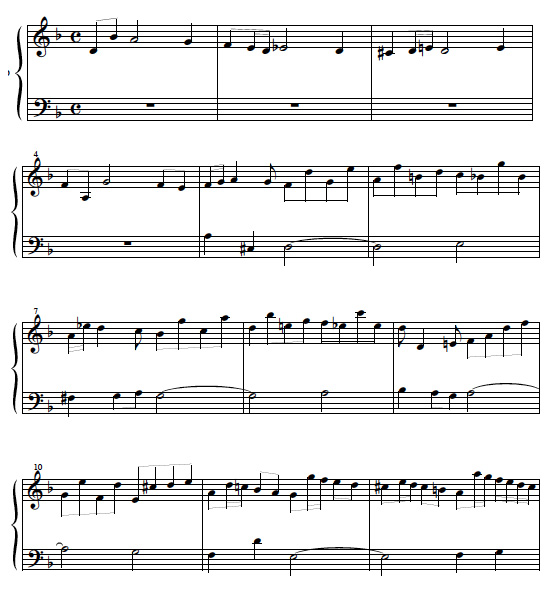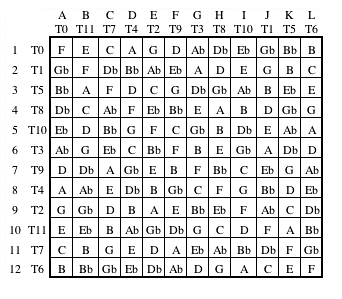Algorithmic Composition: A Gentle Introduction to Music Composition Using Common LISP and Common Music
Skip other details (including permanent urls, DOI, citation information): This work is protected by copyright and may be linked to without seeking permission. Permission must be received for subsequent distribution in print or electronically. Please contact [email protected] for more information.
For more information, read Michigan Publishing's access and usage policy.
2.2 A Brief History of Algorithmic Processes Applied to Music Composition
The Greek philosopher, mathematician, and music theorist Pythagoras (ca. 500 B.C.) documented the relationship between music and mathematics that laid the foundation for our modern study of music theory and acoustics. The Greeks believed that the understanding of numbers was key to understanding the universe. Their educational system, the quadrivium, was based on the study music, arithmetic, geometry, and astronomy. Although we have numerous treatises on music theory dating from Greek antiquity, the Greeks left no clues if mathematical procedures were applied to the composition of music.
Over a thousand years later, the work of music theorists such as Guido d'Arezzo established the framework for our conventional system of music notation. His system employed a staff accompanied by a clef making it possible for a composer to notate a score so that it could be performed by someone other than the composer. Prior to the development of the score, music was learned by rote and generally improvised and embellished by the performing musician. By the thirteenth century, formalized music composition began to replace improvisation and the role of composer and performer became increasingly distinct.
The music theorist Franco of Cologne established rules for the time values of single notes, ligatures, and rests in his treatise Arts canus mensurabilis (ca. 1250). By the early fourteenth century, composers began to treat rhythm independently of pitch and text. French composers of the ars nova , such as Phillipe de Vitry and Guillaume de Machaut, used isorhythm as a means of unifying their compositions. Iso means "same" so isorhythm means literally "same rhythm." Isorhythm is the practice of mapping a rhythmic sequence, named the talea , onto a pitch sequence called the color . Figure 2.2.1 depicts the talea from the motet De bon espoir-Puisque la douce-Speravi by Guillaume de Machaut.
Figure 2.2.1: Talea of the isorhythmic motet De bon espoir-Puisque la douce-Speravi by Guillaume de Machaut
The next figure shows the color of the same motet.
Figure 2.2.2: Color of the isorhythmic motet De bon espoir-Puisque la douce-Speravi by Guillaume de Machaut.
The tenor of De bon espoir-Puisque la douce-Speravi was derived by mapping the color onto the talea as shown in Figure 2.2.3.
Figure 2.2.3: The tenor of De bon espoir-Puisque la douce-Speravi by Guillaume de Machaut
Phillipe de Vitry used a palindrome in the construction the talea for his isorhythmic motet Garrit gallus - In nova fert. A palindrome is a pattern that reads the same forwards as it does backwards. Figure 2.2.4 shows the organization of the palindrome by measure. Measure 1 compares to measure 9, measure 2 compares to measure 8, etc.
Figure 2.2.4: The talea of Garrit gallus - In nova fert by Phillipe de Vitry
The Renaissance period witnessed the rise of polyphonic sacred and secular musical forms. By the Baroque Period (1600-1750), highly developed contrapuntal forms such as the canon and fugue flourished. One of the great masters of contrapuntal forms was Johann Sebastian Bach. During the final years of his life, J.S. Bach composed such didactic contrapuntal works such as the Musical Offering and The Art of the Fugue [Bach, 1752]. The Art of the Fugue is a brilliant pedagogical tool for the study of counterpoint that systematically documents the procedure of fugal and canonic composition.
The canon is a highly procedural contrapuntal form. The composer begins with a melody, called the leader, which is strictly followed at a delayed time interval by another voice, called the follower. Sometimes, the follower may present a variation of the leader through transposition, augmentation, or inversion. Figure 2.2.5 shows an excerpt from The Art of the Fugue by J.S. Bach that is a canon in both augmentation and inversion.
Figure 2.2.5: Canone I from The Art of the Fugue by J.S. Bach
In the final fugue of The Art of the Fugue, Fuga XV , J.S. Bach uses his own name,B-A-C-H, as the subject of the fugue: B-flat, A, C, and H. (H is the German letter for B). His name is embedded in one of the most masterful contrapuntal works of all time.
Figure 2.2.6: Excerpt from Fuga XV from The Art of the Fugue by J.S. Bach
One of the most often cited examples of algorithmic music in the Classical Period (1750-1827) is Musikalisches Würfelspiel by Wolfgang Amadeus Mozart (1756-1791). In this composition, Mozart composed discrete musical excerpts that could be combined to form a waltz. The order of musical excerpts was determined by rolling two six-sided dice. The person assembling the waltz would refer to a table created by Mozart that showed which music should be used for the values of 2-12 on the dice.
Romanticism pushed the harmonic vocabulary into the extreme use of chromaticism. After Richard Wagner (1813-1883), there was very little a composer could do that would be considered novel using tonal music theory. Arnold Schoenberg, and his pupils Anton Webern and Alban Berg, established new procedures for composition called serial composition .
In serial composition, the composer works with a series of twelve chromatic tones of equal importance. In strict serial composition, no tone may be repeated until all twelve have been used. The total number of twelve-note series is 479,001,600 [Brindle, 1969] which greatly expands the melodic and harmonic vocabulary of the late Romantic period. Because of the equal importance of the twelve chromatic tones, serial composition eroded tonality and gave rise to atonality.
Algorithmic procedures lend themselves well to serial composition. To introduce variation into a serial composition, the composer may use permutations of the tone row derived from transposition, inversion, retrograde, or retrograde inversion of the row. Figure 2.2.7 shows the tone row used by Alban Berg in the Lyric Suite for string quartet composed in 1926.
Figure 2.2.7: The tone row for the Lyric Suite by Alban Berg
Figure 2.2.8 shows a matrix that was constructed based on the tone row from Alban Berg's Lyric Suite . The Rows are numbered 1-12 and the Columns are labeled A-L. The original form of the tone row is found in Row 1, Columns A-L, reading from left to right. The retrograde form of the tone row is found by reading Row 1, Columns A-L, reading from right to left. The inversion of the tone row is found in Column A reading Row 1 to Row 12 and the retrograde inversion is found in Column A reading from Row 12 to Row 1. Each Row and Column is further labeled with T followed by a value in the range 0-11. The T stands for transposition and the number is the level of transposition measured in half steps from the original tone row. For example, T5 means the tone row has been transposed up five half steps from the original form (e.g. a Perfect Fourth).
Figure 2.2.8: Tone Row Matrix for Alban Berg's Lyric Suite
About the same time Alban Berg completed the Lyric Suite , Iannis Xenakis (1922-) began to make his way in the world. Xenakis received an engineering degree from the Athens Polytechnic School and studied music composition with Honegger, Milhaud, and Messiaen and architecture with Le Corbusier. Xenakis was keenly interested in the application of mathematics to music composition. In 1966, Xenakis founded the School of Mathematical and Automated Music in Paris. His music is described as stochastic music meaning he uses probability theory in the selection of musical parameters. Xenakis exploited probability theory in his search for new musical form and structure. One of Xenakis' well-known works, Pithoprakta (1955-56), creates dense sound masses determined by probabilistic methods.
The music of Karlheinz Stockhausen (1928-) stands in sharp contrast to that of Iannis Xenakis. Stockhausen developed serial composition to its extreme by not only applying serial methods to pitch, but also rhythm, dynamics, timbre, and density. Stockhausen was influenced by the German philosopher Hegel and his doctrine on the unity of opposites. Stockhausen applied Hegelian philosophy by using calculations to pre-compose his music while integrating chance operations into the performance. A stunning example of his work is the Klavierstück X1 (1956) composed for piano. The score, measuring about thirty-seven inches by twenty-one inches, consists of nineteen carefully composed segments that the pianist performs in whatever order his or her eye happens to fall upon the score. Stockhausen employed chance operations similar to those explored by Mozart in his Musikalisches Würfelspiel almost two hundred years earlier.
About the same time Stockhausen composed the Klavierstück X1, Lejaren Hiller and Leonard Issaacson were preparing to significantly alter the course of music history. Ada Augusta, Countess of Lovelace worked with Charles Babbage on the development of a mechanical computer called the Analytical Engine. In 1842, she described the use of the computer in the creation of music and foretold the era of computer-assisted composition heralded by Hiller and Isaacson:
"The operating mechanism [of the Analytical Engine]. . .might act upon other things. . . whose mutual fundamental relations could be expressed by those of the abstract science of operations, and which should be also susceptible of adaptations to the act ion of the operating notation and mechanism of the Engine. Supposing, for instance, that the fundamental relations of pitched sounds in the science of harmony and of musical composition were susceptible of such expression and adaptations, the Engine might compose and elaborate scientific pieces of music of any degree of complexity or extent." [Roads, 1996]
It was 1957 when Lejaren Hiller and Leonard Isaacson programmed the ILLIAC computer at the University of Illinois to algorithmically generate music. The output of their software created The ILLIAC Suite scored for string quartet. The work of Hiller and Issaacson is documented in the book "Experimental Music." [Hiller, 1959]. By 1962, Xenakis began to use the computer to assist in the calculations for his compositions Amorsima-Morsima and Strategie, Jeu pour deux orchestres.
John Cage (1912-1992) was a self-declared indeterminist. Cage integrated Eastern philosophies, especially Zen Buddhism, and the I Ching Book of Changes, into his compositions. A landmark collaboration between Cage and Hiller resulted in the multi-media composition HPSCHD (1967-1969), The composition uses computer print outs, excerpts of traditional music, and visual elements depicting space and rocket technology. The traditional music is derived from Mozart's Musikalisches Würfelspiel and his piano Sonatas. Cage's statement, "it is the machine that will help us to know whether we understand our own thinking processes," demonstrates his philosophical comradeship with Lejaren Hiller. HPSCHD requires up to seven harpsichords and fifty-one electronic tapes that are combined in any possible way to achieve unique performances. The composition received its world premiere before an audience of nine thousand at the University of Illinois on May 16, 1969. The performance included all seven harpsichords, fifty-one computer-generated tapes, eighty slide projectors, and seven film projectors.
For over two thousand years, composers have used algorithms to assist in the creation of new works. Algorithms for music composition have evolved into several categories: aleatoric (or chance) methods [e.g. Cage]; determinacy [e.g. Schoenberg, Webern, and Berg]; and stochastic (or probabilistic) methods [e.g. Xenakis and Hiller]. Composers are applying not only mathematical models but also biological paradigms to the creation of music. Since almost any process may be modeled using a computer, almost any model may be used for music composition.
The principle questions facing composers who use algorithmic processes are rooted in aesthetics and philosophy. Why use algorithms in the composition of music? What is more important- the algorithm or the composition? How does a composer or listener decide if an algorithmic composition is successful?









